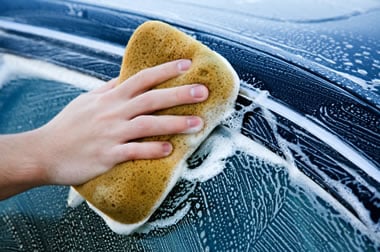
Okay, so maybe your teenager borrowed the car and he mysteriously came home with a strange scratch on the hood. Or perhaps you were the unfortunate victim of someone who decided to wrongfully key your door. Maybe you were hit by a runaway shopping cart or a basketball or meteor debris (you never know).
No matter how it happened, if you have scratches in your car’s paint it can be pretty annoying.
So what do you do? Well, the good news is that there is a way to remove minor scratches on your own without having to take your car in for repainting. Just follow the steps below:
-
The first thing you need to do is to inspect the damage. How deep is the scratch? Is it even a scratch at all? In many cases, what looks like a scratch is actually residue from whatever it was that hit you (the basketball, shopping cart, or something else). The way to test it is to gently scrub the area with soap, water, and a non-abrasive cloth. If the mark begins to fade, then keep going until it’s gone. If it doesn’t budge, then it sounds like you have a real scratch on your hands.

-
Next you’ll need to determine how deep the scratch is. A car’s paint most often consists of primer, paint, and a top clear coat. It will be much easier to remove the scratch if it is only in the top clear coat. Here’s a great guide from Popular Mechanics for out to sand away the scratch:
-
The key to sanding safely is to use an ultrafine 2000- to 3000-grit wet/dry sandpaper, which is available at auto parts stores where body shop supplies are sold. Place the paper on a rubber sanding block or a wood block, then dip it in a bowl of cold water. Add two or three drops of liquid dish detergent to make the water more slippery and to improve cutting action. Sand the scratch area using light, short strokes at alternating 60-degree angles to the scratch. Move up and down the length of the scratch, stopping frequently to rinse the paper in the water. The goal is to work slowly and lightly until you see the contrasting mark disappear.

-
Once it is gone, dry the sanded area thoroughly and inspect it for any signs of the scratch. If you have clearcoat paint and the sanding water shows any sign of color, you’ll have to respray the clear. If you have conventional (nonclearcoat) enamel or lacquer, the water will show plenty of color. Once the scratch is gone — and you haven’t sanded down to the next layer — buff the area with rubbing compound. A power buffer works fast, but you can do a fine job on smaller areas with no more than a terry cloth washcloth and a bottle of compound. Buff in a circular motion, and lift up the haze with a terry cloth towel.
-
When the sandpaper scratches are gone, use a soft cloth to remove any of the relatively coarse compound. You may need to wash the area with water. Replace the rubbing-compound pad on the machine with a foam polishing-compound pad, and buff the entire area with very fine compound or swirl mark eliminator. Once the polishing is done, inspect the area, then seal the paint with car wax.
-
If the scratch you have goes deeper than the clear coat or if you just want to save yourself the trouble of trying DIY methods, then give Bel Air Autobody a call. We can eliminate not only scratches, but also any autobody damage you have, no matter how minor or major. At Ward Automotive and Bel Air Autobody we have built our reputation on being an honest and trustworthy repair facility. We service the residents of Harford County and we too are proud Harford County residents. If you are looking for a neighborhood body shop that you can trust, rest assured that you have come to the right place at Bel Air Autobody. Bel Air Autobody and Ward Automotive have been servicing the residents of Harford County, Maryland for over 20 years.

